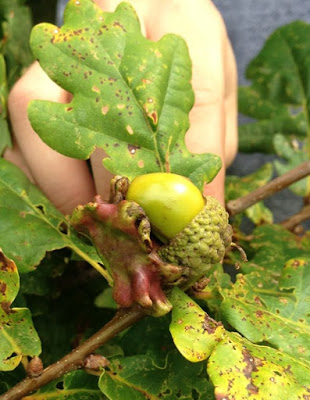Galls are weird. A parasitic insect lays its egg in the epidermis of a leaf, it hatches out and the tiny larva then exudes hormones, messing with the plant's cell division and causing mutations of plant tissue.
Spangle Galls on an Oak leaf. At the top near the thumb is a young Cherry Gall
These mutations form specific structures to each species, which become a source of food and protection for the larva. A rather enclosed and sedentary lifestyle, kinda of like ecologists writing up their survey reports in winter.
Ecology student Felix identifies gall species in Goat Meadow
Felix is a 3rd year Ecology project student, visiting our biodiversity sites from Royal Holloway University (my old stomping ground). He is studying the prevalence of galls on Oak leaves, looking for differences between species in changing environmental conditions.
Silk Button Spangle Gall (Neuroterus numismalis)
The types of gall he is studying are formed by tiny wasps of the family Cynipidae. This group contains many species, and the adult wasps are so small that we barely notice them. It is much easier to identify the species by the unique structures their larvae have created.
Smooth Spangle (Neuroterus albipes)
At the top of the picture: Common Spangle Galls (Neuroterus quercusbaccarum)
You can often have several different gall species on one leaf. The darker one below these Common Spangles is quite an unusual one...
Cupped Spangle (Neuroterus tricolor)
Either this species is very uncommon, or just particularly under recorded in the UK. In any case, an interesting find and I reckon the species distribution map could do with updating.
Despite the tough materials which galls are formed from, they are not immune from enemy attack...
Looking more closely, Felix spotted this tiny shady character hanging out on out the Silk Button Spangles, and she is no galler...
A torymid wasp
This is a 'parasitoid' of the gall wasps, using a long ovipositor to lay her own eggs deep into the spangles. Her larva will then hatch and slowly feed on the other within (nature is pretty brutal). I googled the Torymidae wasps to find out more, and found out a few species are hyperparasitoids, meaning they are parasitoids of the parasitoids... I then stopped reading and went to bed.
Here are a few other weird and wonderful species of gall about the place, all belonging to the family of cynipid wasps:
Knopper Gall (Andricus quercuscalicis) growing on an acorn
Marble Gall (Andricus kollari) on a leaf bud
Cherry Gall (Cynips quercusfolii) growing on a leaf vein
Robin's Pincushion (Diplolepis rosae) on a wild rose leaf bud
Not only galls are found hanging about on the Oak leaves...
Possibly a Grey Dagger Moth caterpillar, which has a cool species name (Acronicta psi)
Theridion pallens; a tiny comb-footed spider. The female is guarding her sputnik-like egg case
Good luck with the rest of the project Felix (particularly the statistical analysis part, I've been there myself)!
















No comments :
Post a Comment